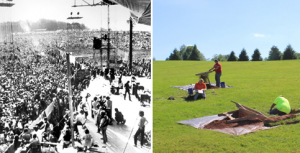Almost five decades after Woodstock, archaeologists from Binghamton University’s Public Archaeology Facility (PAF) are investigating the site of the iconic music festival. Although the grassy hill in Bethel, New York, once accommodated around 400,000 concertgoers, almost nothing remains visible today to indicate that greats such as Janis Joplin, Jimi Hendrix, and the Grateful Dead once played there. The work is a collaboration between the PAF and the Museum at Bethel Woods in anticipation of the festival’s fiftieth-anniversary celebration in August 2019. “It is the essence of a public archaeology project,” says PAF director Nina Versaggi. “Woodstock was a defining moment in the American experience, and it created a counterculture revolution that changed a whole generation.”
The team has successfully identified the area of vendors’ booths known as the Bindy Bazaar, as well as the site of the sound and light towers and the “Peace Fence” that once ran parallel to the stage. Versaggi hopes that this new information, coupled with period photographs, will help pinpoint the legendary stage’s exact location, which is not known. “Archaeologists are trained to find the ephemeral as well as the amazing,” she says, “and the ephemeral traces of Woodstock are pretty amazing.”
Source: archaeology
Ask me anything
Explore related questions





